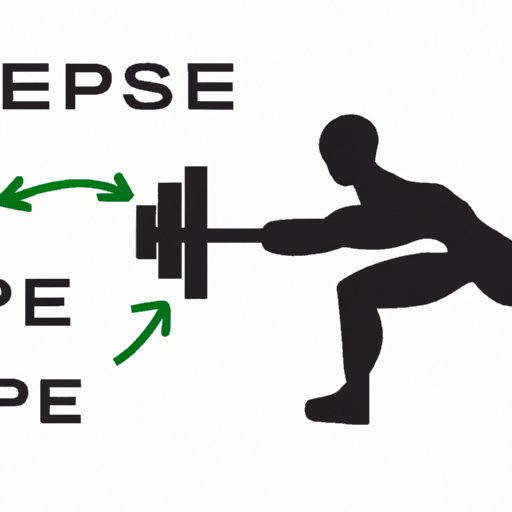
Introduction
When it comes to exercise, one term you hear often is “reps.” But what exactly does it mean, and why is it important? Simply put, reps refer to the number of times you perform a specific exercise. Reps, along with sets and weight, are fundamental components of your workout routine and are crucial to achieving your fitness goals. In this article, we’ll explore everything you need to know about reps, from understanding the basics to maximizing your workout potential.
Understanding Reps
Before we dive into the specifics of reps in exercise, let’s first define what it means. Reps, or repetitions, refer to the number of times you perform a specific exercise before resting. For example, if you do 12 bicep curls in a row, that’s considered 12 reps.
There are different types of reps you can perform to achieve specific goals. For example, tempo reps involve slowing down the movement to increase muscle tension, while partial reps involve only doing a portion of the full movement to focus on specific areas. Additionally, varying the range of motion during a rep can target certain muscle groups and add variety to your routine.
Reps are essential for building strength, endurance, and muscle growth. For muscle growth, the optimal rep range typically falls between 8-12 reps, while lower reps (around 1-6) are ideal for building strength, and higher reps (around 15-20) are best for endurance.
Finding Your Ideal Rep Range
Selecting the right rep range for your fitness level and goals is crucial. Factors that can influence your selection include the type of exercise you’re performing, your fitness goals, and your experience level. For example, if your goal is to increase endurance, higher reps may be more appropriate, while building strength may require lower reps with heavier weights.
To determine your ideal rep range, start by experimenting with different ranges and noting how your body responds. Pay attention to the burn in your muscles and adjust as necessary. Additionally, it’s important to listen to your body and avoid pushing yourself beyond your limits, as this can lead to injury.
Overall, the key to selecting the right rep range is finding a balance between intensity and sustainability. You want to challenge yourself but also ensure you can maintain proper form throughout the workout.
Maximizing Your Reps
Once you’ve selected your ideal rep range, there are several ways to optimize your reps for maximum effectiveness. First and foremost, it’s important to select an appropriate weight for each exercise. The weight should be challenging but still allow you to complete the desired number of reps with proper form.
Another important factor to consider is your breathing technique. Proper breathing can help you maintain control throughout each rep and ensure adequate oxygen delivery to your muscles. Aim to exhale during the exertion phase (i.e., when you’re lifting the weight) and inhale during the relaxation phase.
Common mistakes to avoid when counting reps include not completing a full range of motion, rushing through the movement, and not maintaining proper form. A lack of attention to detail in each rep can jeopardize the effectiveness of your workout and lead to injury. If you find yourself making these mistakes, take a step back and slow down. Focus on performing each rep with intention and proper form.
The Science of Reps: Impact on Muscle Groups
Reps can have various impacts on different muscle groups in your body. For example, primary muscles (i.e., the muscles targeted by a specific exercise) may fatigue before secondary muscles, which can lead to an uneven distribution of muscle activation. Additionally, higher reps can lead to greater muscle endurance, while lower reps with heavier weights tend to activate muscle fibers most responsible for strength.
Proper technique is critical for maximizing muscle activation during reps. Ensure you’re performing each exercise with correct form and range of motion to target the intended muscle group fully. Maintaining an appropriate rep range and challenging yourself with heavier weights can also lead to improved muscle activation and increased growth.
Top 5 Rep-Based Exercises to Add to Your Routine
There are plenty of exercises you can incorporate into your workout routine to target different muscle groups and rep ranges. Here are five of our favorite exercises that focus on reps:
1. Squats – ideal for building lower body strength and endurance
2. Lunges – engages multiple lower body muscle groups and can be varied for different rep ranges
3. Push-ups – targets upper body and is a great bodyweight exercise for building strength and endurance
4. Dumbbell curls – works biceps and is easily adjustable for different rep ranges
5. Plank – engages core muscles and is effective for building endurance
Innovations and Future Trends
With advances in technology, there are new tools available to help guide rep selection and performance. For example, smart workout machines can automatically adjust weight and rep ranges based on personalized fitness data. While technology can be beneficial, it’s also important to listen to your body and avoid relying too heavily on machines to direct your workouts.
Looking toward the future, there is much to be explored around the science of reps and their impact on muscle activation and growth. Continued research in this area has the potential to inform new recommendations and advancements in exercise science.
Conclusion
Overall, reps are a fundamental aspect of any exercise routine, and selecting the right rep range can help you achieve your fitness goals. Remember to experiment with different ranges and listen to your body, and don’t forget to optimize your reps by selecting appropriate weights and maintaining proper form. By incorporating rep-based exercises such as squats, lunges, and push-ups into your routine, you can effectively target different muscle groups and improve your overall fitness.





